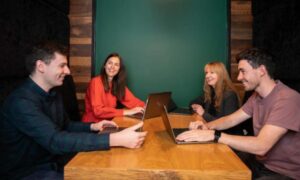Covid-19 has prompted major changes in both business and consumer behaviours. While online shopping and work from home seem here to stay, one look at queues for stores such as Penneys on reopening suggests that shoppers like an in-store experience. However, people are now far more comfortable using technology for both work and shopping and are certainly more aware of the best places to shop online.
The biggest change for many consumers is the location of purchase. Consumers had to find new ways to consume and businesses needed to find new ways to do business. Traditional patterns of consumption built up and at best tweaked over hundreds of years were disrupted overnight, says Niall Savage, partner and head of retail and manufacturing at KPMG.
But smart businesses were already offering multiple channels. “Due to restrictions, entire industries had to find a way to get their products and services into your house. So we have seen people research, design, order, return and even experience products without walking out the front door. You can now buy a car, go to a concert, do the weekly shop and take a spin class from the comfort of your home. Things we thought could not be done online were done surprisingly effectively,” he says.
Consumers are now set up and are comfortable buying products with a few clicks on PayPal, Revolut or through their own accounts in bigger stores. They also trust a host of new stores who hasn’t let them down when everything else was pretty bleak, he adds.
“We are not going back,” Niamh O’Brien, director at BDO Talent Management, points out.
“The pandemic has condensed five years of e-commerce growth into a single year. The result is that brands and categories that had traditionally resisted e-commerce have now embraced it. Brands that were already selling via e-commerce have accelerated their e-commerce programmes,” she says.
One of the biggest beneficiaries has been the e-commerce platform Shopify, with its chief operating officer, Harvey Finkelstein, suggesting the world that would have existed in the year 2030 has been pulled into 2020.
Smartphone penetration has been a key driver for this, O’Brien says: “Research indicates that smartphones are underpinning the consumer behavioural shift, creating an ability to browse and shop via mobile 24/7. The availability and ease of use of cloud-based e-commerce platforms such as Shopify or BigCommerce also mean that setting up an eCommerce store has become ‘democratised’ – much easier to do and at a very low cost. This has resulted in an explosion of e-commerce stores – which in turn has built an expectation that retailers will have an e-commerce option.”
Virtual working
While the future of work arrived abruptly into the present, virtual working has steadily evolved in the last year, says Julie Ryan, head of custom solutions and client development at the Irish Management Institute.
“There is a recognition that the new ways of working are fostering a new way of work. Organisations are becoming way more flexible in how they think about location, space, talent, and time. So how do we use this to our advantage to foster higher levels of performance and engagement?
“There has been an increased use of digital tools in both life and business and the lines are now blurred between work and lifestyle and social interaction. The implications are huge for management, performing in the now and future-proofing. It’s much more prevalent than it has been before,” she says.
Karen Killalea, head of the employment practice at law firm Maples and Calder, says one of the magic ingredients that helped office-based businesses pivot overnight to a digital workplace should be celebrated and that is trust.
“Before 13 March 2020, many employers and business owners really struggled to see any benefit to employees being in a sustained remote-working pattern. But the remote-working experiment which has now endured for well over one year has revealed that if employees have the right tools and knowledge; clear communications on expectations; and the trust of their manager to get on with it then, in the vast majority of cases, employees will deliver for you no matter where they are located,” she says.
“Presenteeism is out of favour and no one will mourn its passing. It is frankly a useless metric that has dominated for far too long. Focusing on contribution, output, and other tangible metrics is more equitable. Plus it simply makes business sense,” she adds.
Food services
In terms of the food-services industry, there has been a rapid acceleration of trends in hospitality that are now here to stay. Collaborating with their colleagues across the globe, Aramark has been adapting and expanding its offering to meet emerging consumer demand.
In terms of a return to the office, Frank Gleeson, president of Aramark, says they are working with their clients to focus on why and how those who return will get the most from their experience.
“Everyone won’t go back to the traditional five-day working week in the office, but employers need to remember the valuable role the office plays in engaging employees, creating culture, and providing an experience for their clients,” he says.
For those who return, establishing and safeguarding visibly safe working environments will be the biggest challenge – particularly as highly transmissible infections become a potential new reality in our lives.
“For Aramark, our initial focus is to create a safe working environment, alleviate any potential customer concerns, and restore customer confidence by going beyond compliance to create spaces that people can feel truly comfortable in again – spaces that work for employees, not just spaces that employees work in,” he says.
“Digital transformation has forced a massive reduction of touchpoints on the consumer journey – always an exciting and important thing. We’re currently working on an autonomous, frictionless store solution, a rise in grab-and-go food service, and a rise in app-based office catering solutions, to name a few,” he adds.
As the world emerges from lockdown and businesses reopen their doors, it would appear that people will research a lot more online for bigger purchases but will want to go the extra mile to “experience” them, so car showrooms, furniture and lighting, and showhouses will remain. And while much has changed, there will always be demand for physical experiences such as concerts, cinema, and dining, and “of course, some things can never be done online, as 90 percent of haircuts over lockdown showed,” Savage laughs.










